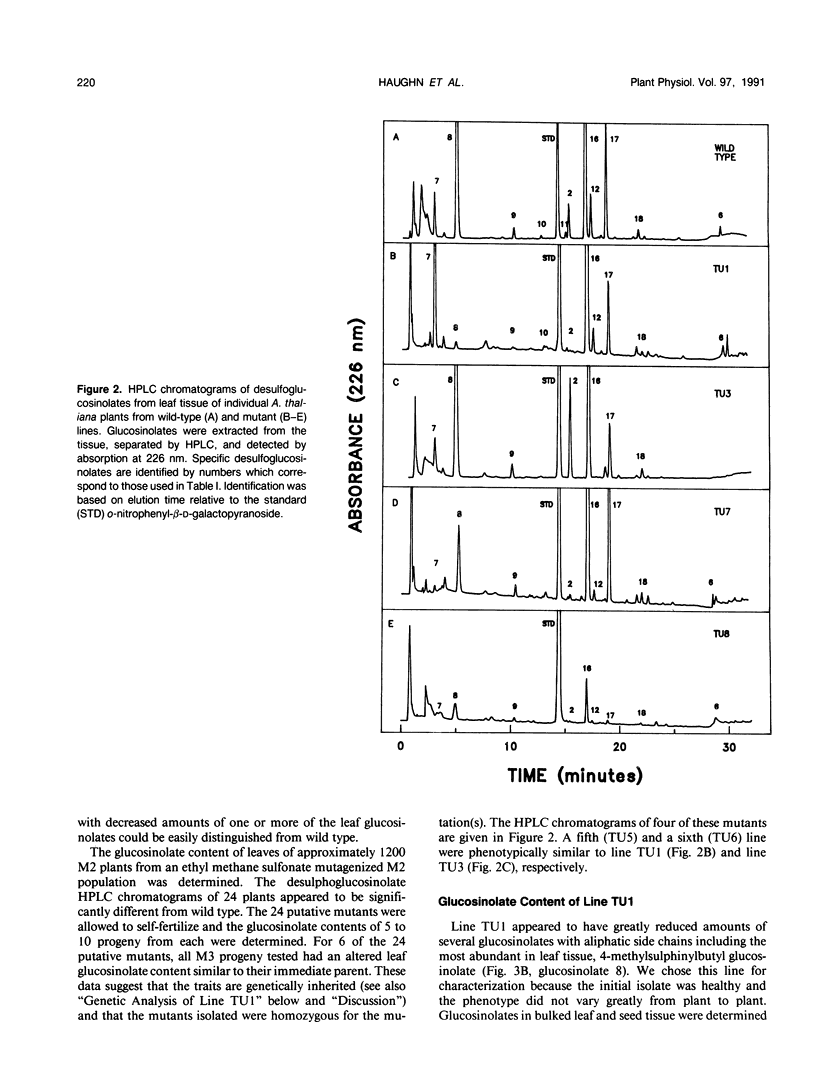Abstract
Mutants of Arabidopsis thaliana with a glucosinolate content different from wild type were isolated by screening a mutagenized population of plants. Six mutants were detected out of a population of 1200 screened. One of these mutants, TU1, was analyzed in detail. Leaf and seed tissues of line TU1 lack or have reduced amounts of many of the aliphatic glucosinolates found in the wild type due to a recessive allele, gsm1, of a single nuclear gene, GSM1. The seed phenotype is inherited as a maternal effect suggesting that the embryo is dependent on the maternal tissue for its glucosinolates. Experiments involving feeding of 14C-labeled intermediates suggested that the gsm1 allele results in a metabolic block which decreases the availability of several amino acid substrates required for glucosinolate biosynthesis: 2-amino-6-methylthiohexanoic acid, 2-amino-7-methylthioheptanoic acid, and 2-amino-8-methylthiooctanoic acid. The mutation does not result in any obvious changes in morphology or growth rate. A pathway for the biosynthesis of glucosinolates in A. thaliana is proposed.
Full text
PDF









Selected References
These references are in PubMed. This may not be the complete list of references from this article.
- Fenwick G. R., Heaney R. K., Mullin W. J. Glucosinolates and their breakdown products in food and food plants. Crit Rev Food Sci Nutr. 1983;18(2):123–201. doi: 10.1080/10408398209527361. [DOI] [PubMed] [Google Scholar]
- Gijzen M., McGregor I., Séguin-Swartz G. Glucosinolate uptake by developing rapeseed embryos. Plant Physiol. 1989 Jan;89(1):260–263. doi: 10.1104/pp.89.1.260. [DOI] [PMC free article] [PubMed] [Google Scholar]
- Jain J. C., Reed D. W., GrootWassink J. W., Underhill E. W. A radioassay of enzymes catalyzing the glucosylation and sulfation steps of glucosinolate biosynthesis in Brassica species. Anal Biochem. 1989 Apr;178(1):137–140. doi: 10.1016/0003-2697(89)90369-2. [DOI] [PubMed] [Google Scholar]
- KUTACEK M., PROCHAZKA Z., VERES K. Biogenesis of glucobrassicin, the in vitro precursor of ascorbigen. Nature. 1962 Apr 28;194:393–394. doi: 10.1038/194393b0. [DOI] [PubMed] [Google Scholar]
- Kindl H. Oxydasen und Oxygenasen in höheren Pflanzen, I. Uber das Vorkommen von Indolyl-(3)-acetaldehydoxim und seine Bildung aus L-Tryptophan. Hoppe Seylers Z Physiol Chem. 1968 Apr;349(4):519–520. [PubMed] [Google Scholar]
- Lizotte P. A., Poulton J. E. Catabolism of Cyanogenic Glycosides by Purified Vicianin Hydrolase from Squirrel's Foot Fern (Davallia Trichomanoides Blume). Plant Physiol. 1988 Feb;86(2):322–324. doi: 10.1104/pp.86.2.322. [DOI] [PMC free article] [PubMed] [Google Scholar]
- Mahadevan S., Stowe B. B. An intermediate in the synthesis of glucobrassicins from 3-indoleacetaldoxime by woad leaves. Plant Physiol. 1972 Jul;50(1):43–50. doi: 10.1104/pp.50.1.43. [DOI] [PMC free article] [PubMed] [Google Scholar]
- Møller B. L., Conn E. E. The biosynthesis of cyanogenic glucosides in higher plants. Channeling of intermediates in dhurrin biosynthesis by a microsomal system from Sorghum bicolor (linn) Moench. J Biol Chem. 1980 Apr 10;255(7):3049–3056. [PubMed] [Google Scholar]
- Underhill E. W. Biosynthesis of mustard oil glucosides: 3-benzylmalic acid, a precursor of 2-amino-4-phenylbutyric acid and of gluconasturtiin. Can J Biochem. 1968 May;46(5):401–405. doi: 10.1139/o68-061. [DOI] [PubMed] [Google Scholar]


